I just tried Tonal — here's what this $3,000 machine is like
Plus how it compares to Peloton Guide

After working out with the Tonal home gym system it’s not a question of whether I want to own one, but whether I’d ever be willing to spend $2,995 to never visit a gym again.
Tonal’s been on my radar for a while now, so when I visited the company’s NYC showroom I had some idea of what to expect: A wall-mounted digital weight machine with integrated workout class software, configurable with high-tech handles and form correction when necessary. What I didn’t expect was to enjoy exercising in a way I haven’t since the last time I belonged to a gym.
Like many others two years ago, I closed my gym membership and adopted an at-home workout routine. But I’ll admit mine lacked consistency. I grew bored of following one regimen or relying on one of the best exercise bikes to stay in shape, and found myself endlessly bouncing between trending workout programs and browsing for new machines. Still, I appreciated not needing to leave my house, and that hasn’t changed. I don’t desire returning to a real gym.
Yet I crave the gym’s freedom, or the ability to walk in without a plan and develop weight-lifting, stretching or core sets as I go, depending on how I feel. Call it chaotic, but for me it relieves the intimidation of getting active when I’m not willing to commit to a 30-minute workout class. And that’s how Tonal caught my attention.
Yes, Tonal’s $49 per month membership includes live and pre-recorded classes targeting specific muscle groups or fitness goals like Peloton. But there’s a feature within Tonal that lets you curate a workout too. So you’re not limited to the class selection on those days when you can’t find something that suits your mood, energy level, ect. Better yet, your form will be monitored (which is essential to prevent injuries and move effectively,) even if you bypass the classes.
Exercising in the gym is IRL and to be shared with other paying strangers (members, whatever) who I’d probably take to court if they tried to correct my form.
And also yes, this kind of defeats the point of paying such a high fee. Tonal requires new customers to pay for a full year of membership before presenting the option to pass. But I would still want the option for classes and training programs with target weights in addition to moving at my own will and weight levels. I’d also find it necessary to upgrade to the $495 accessory bundle for all the smart handles and bench. So I’d be looking at a good chunk more than $2,995 for the full Tonal experience.
By comparison, Equinox (the city’s higher-end gym chain) costs just shy of $170 per month and it includes a fully-stocked locker room, sauna space and complementary workout classes. Of course, all this is IRL and to be shared with other paying strangers (members, whatever) who I’d probably take to court if they tried to correct my form.
Get instant access to breaking news, the hottest reviews, great deals and helpful tips.
Tonal vs. Peloton Guide
Tonal is far from the only form-correcting workout program on the market. The Peloton Guide started shipping this week, promising to replicate in-person training from the comfort of your living room. The $295 webcam-looking device requires at minimum a $24/month membership for Guide-specific training, though Guide workouts are also included in the $39/month all-access membership with Peloton Bike and Peloton Tread workouts, too. You'll also want to check out our Tonal vs. Mirror comparison between these two smart mirrors, as well as our NordicTrack Vault review.
Like Tonal, Peloton Guide has a pricey accessory package starting at $545, but it seems like I can use any of the best adjustable dumbbells or free weights I already own. Tonal’s extra attachments are far less optional to the machine’s range of workout options.
That said, any ‘ol free weights don’t have the same intuition of Tonal’s digital weight system, which not only analyzes and tracks your strength levels but can make mid-rep adjustments automatically. For example, Tonal was able to increase my load during eccentric movements, since I enabled Smart Flex mode before starting a 20-minute upper body class.
So while Peloton Guide poses a more affordable means to bypass the gym and still have my form monitored, it doesn’t offer nearly as sophisticated or personalized weight-training programs. I would need to weigh how serious I am about getting stronger if I were torn between Tonal vs. Peloton Guide. Guide seems like a good beginner option, whereas I would’ve struggled with Tonal if I didn't know my way around a cable machine.
Is Tonal worth it?
In my short workout session with Tonal, I think it’s worth it for multiple reasons. Customizable workouts with form correction in an all-in-one, gym-replacing machine is the home exercise experience I’ve been looking for.
I also priced out how many years it would take to pay off a Tonal in relation to the $170/month gym membership fee I mentioned earlier (which is on the costly end of gym membership options, I’ll admit.) About $170/month for four years would cover the machine and all its added costs. I also live alone, limiting the payoff if a few house members shared a Tonal instead of all belonging to a gym.
So would I rather pay the same price for a gym membership month-to-month or commit to several years of strength-training? Or is Peloton Guide the ideal option for me in the interim? I might need to see what’s new with the best workout apps right now before making a big investment. But if I could comfortably afford it, my own Tonal would already be ordered.

Kate Kozuch is the managing editor of social and video at Tom’s Guide. She writes about smartwatches, TVs, audio devices, and some cooking appliances, too. Kate appears on Fox News to talk tech trends and runs the Tom's Guide TikTok account, which you should be following if you don't already. When she’s not filming tech videos, you can find her taking up a new sport, mastering the NYT Crossword or channeling her inner celebrity chef.
